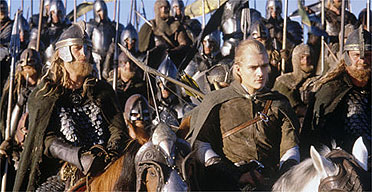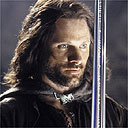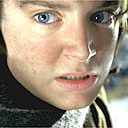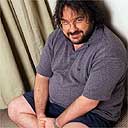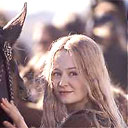The true star of this season's biggest movie is a simple band of gold. It is the One Ring; the ring to rule them all, and bring them all and in the darkness bind them all. Few have actually laid eyes on it, and yet the whole planet knows of its existence. The success or failure of thousands depends upon its fate.
As with the ring, so with the movie. Until now, the first instalment in Peter Jackson's much-hyped Lord of the Rings trilogy has been kept as cloistered as Howard Hughes. There was a sneak preview for distributors in LA last week, and rumours of another clandestine screening somewhere in England a few days ago. But that's about it. Many of the cast have yet to see the final cut. It is at once the most exposed and the least visible film in recent cinema history.
All that is about to change. Shot as one project, the $300m overhaul of the JRR Tolkien trilogy will be released as a trio of three-hour spectaculars. The first, The Fellowship of the Ring, goes global across 10,000 screens on December 19. The as-yet-unedited further instalments (The Two Towers and The Return of the King) follow, respectively, at the end of 2002 and 2003. Revile JRR's yarn as no more than inflated fairytale tosh? Too bad: there will be simply no escaping it.
As 100m readers will tell you, Tolkien's story ends with hobbit hero Frodo Baggins saving the world (Middle-earth) from evil. For those involved in the movie, the stakes are more coldly commercial. Backers New Line Cinema (an independent affiliate of AOL-Time Warner) have taken an unprecedented leap in the dark with The Lord of the Rings. Not only have they drummed up a budget far in excess of their usual $30m ceiling, they're also risking all on a trilogy of movies without waiting to see if the first delivers.
Should all go to plan, New Line effectively has the Christmas market sewn up for the next three years. If not, they're as stuffed as an unarmed hobbit in a nestful of orcs. "I've heard it said that they're betting the company on this project," says Patrick Frater, editor of the trade magazine Screen International. "And they almost are. It is a big, big gamble."
Peter Jackson, too, is facing his own moment of truth. The film-maker has spent the past seven years tussling with Tolkien, first raising the funds and then marshalling his production army (2,500 crew members, 15,000 extras) around the mountains and soundstages of his native New Zealand. "It has been an all-consuming, exhausting experience," he admits. "At times I think it genuinely drove me insane."
Then again, no one ever said it was going to be easy. Jackson's obsessive, cathedral-building approach may be unorthodox, but there's something appropriate about it too. Because Tolkien's opus is a bit of a freak itself. Published in the mid-1950s, the brainchild of an Oxford professor, it spins twee storybook elements (elves, wizards, goblins) into a baroque monument that has been much mimicked, never equalled. The devil is in the detail. Spanning 1,000 pages top to tail, the trilogy teems with intricate, made-up languages (five, by most counts) and culminates in a rash of appendices, maps and family trees. At times it reads like a scholar's text run horribly out of control. "You have to remember that Tolkien spent his entire life developing the history of Middle-earth," Jackson explains. "That's what separates it from other fantasy novels. It feels historical rather than fantastical. You believe in the myth."
As such, the work has always presented something of an Everest for prospective film-makers: too complex and too costly to do justice to. Certainly the one previous attempt notoriously ended in disarray. Made in 1978, Ralph Bakshi's reckless animated version managed to clamber through the first book and a half before expiring inconclusively on the road to Mordor. "Actually I have quite fond feelings for that film," shrugs Jackson. "I know it's confused and messy and stops halfway through. Plus it's dated very badly - it's like looking at a piece of bad 70s art. But I saw it when it first came out and it blew me away. I was 16 or 17 and the film inspired me to read the books."
From here Jackson would carve his own niche in the fantasy genre. His monster-movie debut Bad Taste - shot in his own backyard on a second-hand $250 camera - earned him a fervent cult following, while 1994's acclaimed, dreamy Heavenly Creatures sealed his position as one of the world's most promising film-makers. After making his Hollywood debut with The Frighteners in 1996, Jackson initially planned to shoot a remake of King Kong. When the funding fell through, he began weighing up a still more ambitious proposition.
The production history of The Lord of the Rings is a saga almost as familiar as the story itself. From early rumblings to final cut, every new development, each whispered bit of gossip has been remorselessly analysed by the 400-odd (at times very odd) Tolkien fansites that operate around the globe. Ring devotees blanched when original backers Miramax almost scuppered the project by insisting that the trilogy be shoehorned into a single two-hour movie. They breathed a sigh of relief when smaller, braver New Line rode to the rescue. Each new addition to the cast was subjected to rigorous pro and con debate. Ian McKellen's arrival as the wizard mentor Gandalf was generally judged to be a shrewd choice, while Liv Tyler's inclusion as Arwen the elf provoked rumblings of discontent. The key casting of teenaged Elijah Wood as hobbit hero Frodo Baggins (who beat out 150 other candidates for the role) appeared to leave them all a mite nonplussed.
Jackson's cast-list is eclectic to say the least. True, there are many recognisable faces: McKellen, Tyler, Cate Blanchett as the elf queen Galadriel, Christopher Lee as the rogue wizard Saruman, Sean Bean as unstable Boromir. And yet they jostle with a bunch of actors who (as yet) are scarcely household names in their own homes: people like Orlando Bloom (as Legolas), Sean Astin (servant Sam), Billy Boyd (Pippin), Jonathan Rhys-Davies (Gimli) and Dominic Monaghan (Merry). Jackson says that this was intentional. "Tolkien's characters are so beloved and familiar that you have to be careful with them. When you have a famous name colliding with a famous character it can really jar with an audience." From time to time, the official movie website took pains to reassure fans of their fidelity to the text. Ian McKellen even posted a regular diary on his own dedicated site (mckellen.com), drip-feeding the faithful with insider information.
None of which stopped the griping. At various stages, the purists have grumbled over the way Jackson has fleshed out the female roles, or written out the character of Tom Bombadil altogether. Nor were they happy with the decision to strip out the (decidedly naff) sing-alongs that Tolkien was so partial to. One fansite went so far as to take issue with the fact that Sean Bean is blond when the book expressly describes Boromir as a brunette.
By now Jackson has grown inured to the barbs. "When I'm asked how faithful the film is to the books, the answer is either extremely faithful, or not at all. Certain scenes are totally different. Certain lines are totally different. It's all to do with how obsessive you are." Christopher Lee is still more emphatic: "How can you possibly shoot all the books word for word? It's impossible. There has to be some condensing to make it work for an audience."
To be honest, Lee strikes me as a bit of a fanatic himself. Now in his 80th year, the veteran star remembers reading the books when they first came out and fantasised for years about acting in an adaptation. He clearly knows his Tolkien. When I ask a softball question about what it was like to play Saruman, he responds with a learned lecture about Isildur and the Istari and a stern correction of the way I pronounce the name of the dark lord Sauron. (For the record, it's not Sauron as in dinosaur, but Sauron as in sauerkraut.)
And yet Lee was not the only Rings nut on set. Jackson is at pains to point out that this is a film made by the fans. The evidence bears him out. Billy Boyd recalls how the make-up artists employed to fit him with his hobbit feet would want to engage in lengthy discussions on the text.
There was, though, one group of experts who were kept out of the frame. The author's surviving children benefit from sales of the books, while JRR's son Christopher Tolkien is known to relish his role as the estate's literary custodian. And yet none of the family was involved in the film's production. "Having to run everything past the Tolkien estate would have been a disaster," explains Jackson. "It would have been impossible - we'd have had to answer to them at every turn. By the same token, it would have been frustrating for them to be involved in the film without having an official veto over its content. So we decided very early on that it was best to have nothing to do with each other."
But then Jackson appears to have been a master at retaining creative control. The director claims that his decision to shoot the entire trilogy in his homeland was motivated by the similarities between New Zealand's unspoilt terrain and Tolkien's depiction of a rugged Middle-earth. Yet one also suspects that it also allowed Jackson to keep his production largely free from outside interference. The digital conjury was all handled in-house at Weta, Jackson's custom-built studio in Wellington. Wife Fran Walsh and friend Philippa Boyens helped him write the script. At heart, it was the same cottage-industry aesthetic that Jackson used to make Bad Taste all those years ago, just transferred to a broader canvas. "I know it sounds strange, but it was basically the same," he says. "The problems never change: where to put the camera, what to do with the actors. The scale is the only thing that's different."
Jackson's production went before the cameras in the autumn of 1999. It wrapped a whopping 15 months later. "I looked on it as running a marathon," says Elijah Wood. "You might never do it again, but you're awful glad to have taken part."
Inevitably there were glitches along the way. Hired to play enigmatic ranger Aragorn, young Irish actor Stuart Townsend was fired after a fortnight's filming and replaced with the older, more experienced Viggo Mortenson. The film's initial producer (Tim Sanders) also bit the dust, as did effects wizard Mark Stetson. At one stage three crew members were arrested for trying to flog some of the footage on the internet. "Of course there were difficulties," shrugs Jackson. "When you have a production of this size, it's hard to make everybody gel. But on the whole it's been pretty harmonious."
The actors will agree with this assertion - up to a point at least. Upon finishing the shoot, the nine actors who make up Tolkien's fellowship all tripped along to a Wellington tattoo parlour for a permanent memento of the experience. "I'm pretty sure it was Dom's idea originally, but Viggo came up with the design: the number nine as a Celtic numeral," Boyd says. "Everyone was up for it, except Jonathan Rhys-Davies, who plays Gimli. He sent his stunt double instead." The fly in the ointment, the grit that makes the pearl. No great story would be complete without it.
But is The Lord of the Rings really so great? To check it out, I have to shell out for a brand-new edition. There was some dog-eared copy lying around once, but now it seems to have vanished. Maybe I chucked it out sometime in mid-adolescence, when its brand of high-flown fantasy turned abruptly embarrassing, when the likes of Salinger or Kerouac seemed to be offering something so much more hip and hard-hitting than a bunch of prancing elves and magic rings. The Lord of the Rings is like that for a lot of people. It's a time-specific love affair that one eventually grows out of. Stick with it too long and the book can blight your teenage years. It shoves you into a geek limbo of dubious records and Dungeons and Dragons games. Before you know it, the closest contact you have with a member of the opposite sex is when your role-playing character gets attacked by a busty Amazon outside the tomb of Cleara-Sill. "The Lord of the Rings is tit in some ways," says Jenny Turner, the author of a comprehensive critique of Tolkien in a recent issue of the London Review of Books. "It's an infantile comfort. [But] it's an infantile comfort that is also a black pit."
Re-reading the thing today makes for an odd experience. Tolkien's prose is thun derous, ponderous, devoid of humour and full of clanking, faux-noble sentences ("Neither shaft nor cry came again from the east that night"). Its inhabitants largely serve as shorthand symbols of either heroism or wickedness. Its few female characters are divided into shrews (Lobelia Sackville Baggins) or unattainable goddesses (the insufferable Galadriel).
Annoying to report, then, that this old flame still has some heat to it. Is this purely a case of nostalgia value? Or could it be that Tolkien's work truly was in touch with some fundamental human struggle? "Oh, make no mistake, it is a work of literary genius," says Christopher Lee. "Basically in it's most simplistic form this is the age-old story of good and evil. It's a story of love and hate, beauty and terror. A story of opposites, if you like. All the good qualities that Tolkien believed the human race possessed, and all the bad ones too." McKellen has likened the making of the film to adapting the Bible.
The added difficulty is that this Bible comes in three stages. In a nutshell, The Fellowship of the Ring tells the tale of a band of nine goodies (four hobbits, two warriors, an elf, a dwarf and Gandalf the wizard) charged with destroying a malevolent ring of invisibility. But by the end of part one the fellowship is fractured, and Gandalf has fallen into a pit while battling a Balrog (don't ask). Judged in isolation, The Fellowship of the Ring ends on a profound downer. It sounds a most unlikely Christmas blockbuster; a tale of strife and failure that leaves its viewers dangling for 12 months before finding out what happens next.
The director acknowledges that this is a problem. "By their nature these films have to work on several levels. On the one hand they're part of a continuum, a story in three acts. And on the other they are individual movies. So yes, we had to adapt the endings to make them more satisfying. We didn't want the first two films to end as cliffhangers. That way you send people home feeling anxious." For his own part, Jackson has distinct views on all three instalments. "The Fellowship of the Ring introduces the key characters and begins the journey. There's a lot of groundwork that has to be done. The middle instalment is even more complicated. That's where things go from worse to worse. The last film is my favourite one. By the time you reach part three, there's a degree of freedom that wasn't there before. Part three is just one long climax." Except that this climax is still more than two years away.
The director may dispute the label, but a cliffhanger is precisely what his Lord of the Rings is: an epic, slow-motion cliffhanger that's timed to an annual calendar. The billion-dollar question is whether the public will buy it, whether Tolkien's serious, old-style fantasy can flourish in a genre now ruled by jaunty, kid-friendly Harry Potter. Will the film outrage the faithful by skimming lightly over the surface of Middle-earth? Or will it stick to the letter so doggedly that it taxes the patience of the all-important younger viewers? Is the film an act of heroism that saves a studio stung by the flop showings of Little Nicky and Town and Country? Or is it the folly that sinks them for good?
The answer is still two weeks away. In the meantime, early indications suggest that New Line's gamble may just pay off. For a start, the studio has audaciously demanded that foreign distributors commit to all three films, sight unseen, with fees up-front. Industry insiders predict that, in doing so, the company has already recouped some two-thirds of its original budget - their risk minimised in one fell swoop.
More crucially, there is the buzz building about the film itself. Jackson's intense, expert trailer has been generating fevered word of mouth for several months now. Last week the trade papers reported a positive response to that secret distributors' screening. Sales of the book are up 500% on this time last year. The evidence is encouraging. It appears that there is still a mass Tolkien audience out there after all - be they bright new converts or disillusioned old-timers just waiting to be brought back into the fold.
As for me, I intended to swiftly revisit the first book - purely in readiness for the film, you understand - and then consign the whole sorry farrago to the nearest wastepaper bin. I'm currently midway through book two and finding it hard to get shot of. Yes, The Lord of the Rings is overblown, badly written and as hip as old boots. The trouble is that the Ents are massing against Saruman and Womtongue is making mischief in the court of King Theoden and I vaguely recall that there's some big battle just around the next page or two. Rather worryingly, it feels as though I've never been away.
The Lord of the Rings: Fellowship of the Ring is released on December 19.

